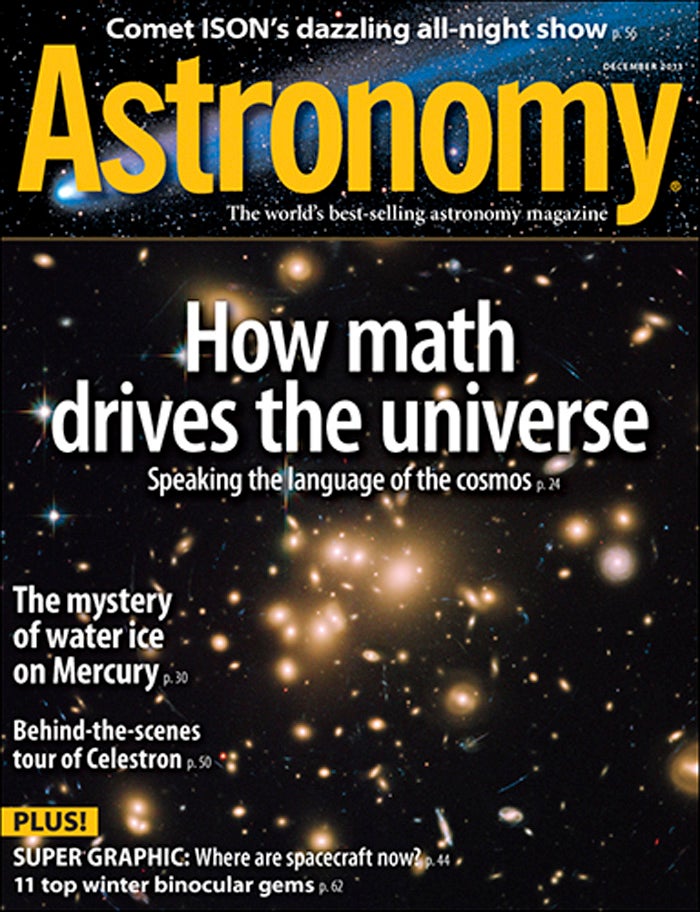
WAUKESHA, Wis. – Understanding astronomy isn’t just about exploring the universe through a telescope. It’s understanding the laws of physics, challenging theories, and testing ideas with simulations. To do this requires math – and lots of it. According to Daniel Kelson, a Carnegie Institution researcher, “As an astronomer, math is all I do. All the time.” But to many, math is a scary subject, one to avoid at all costs. And yet it brings out the greatest splendors and curiosities of astronomy.In “Speaking the language of the cosmos,” Contributing Editor Bob Berman tackles the challenge of explaining some key mathematical concepts that are critical to astronomy. From Kepler’s laws of planetary motion to the Lorentz transformation, seemingly complex equations are everywhere, Berman notes, but they can develop new meaning and use if astronomy enthusiasts just take the time to break them down. So Berman does, revealing how simple math can do anything from reveal distances in our solar system to describe how time stretches and space shrinks when an object moves at a high speed.To better understand the importance of math in astronomy, pick up the December issue of Astronomy, on newsstands November 5.“Torrid Mercury’s icy poles”
The saga of water ice hiding in the shadows on Mercury ranks among the most fascinating chapters in the history of planet formation. Theory says it should be there, but what do observations show? How much is on the world’s surface? How did it get there, and how does it stay frozen on the closest planet to the Sun? In “Torrid Mercury’s icy poles,” James Oberg explores the history of the search for the innermost planet’s water ice and what the MESSENGER spacecraft, launched in 2004, is revealing.“Comet ISON’s dazzling all-night show”
Assuming the celestial visitor survives its harrowing pass by the Sun in November’s final days, Comet ISON promises to be a real treat for northern observers in December. “Comet ISON’s dazzling all-night show” provides details on how bright the comet should be, where to find it in the sky, what to look for, and some specific nights to target as ISON passes near bright stars and a brilliant globular cluster. All signs point to a memorable month for comet observing.“11 top winter binocular gems”
As winter looms in the Northern Hemisphere, amateur astronomers enjoy long nights to spend under the stars. But they also have deal with much colder temperatures. What better way to quickly take in dazzling winter sky objects without freezing during setup time than to observe through binoculars? In “11 top winter binocular gems,” Phil Harrington describes one supernova remnant, two double stars, and eight clusters to check out this December.September sky events visible without optical aid
- December 1 – The Moon meets Saturn, Mercury, and Comet ISON.
- December 6 – Venus gleams at magnitude –4.9, the brightest it gets during this evening apparition.
- December 14 – The Geminid meteor shower peaks.
- December 19 – Jupiter passes a few degrees north of the Moon.
- December 26 – The Moon passes 1.1° north of Spica.
Also in the December 2013 Astronomy
- “Spacecraft: Where are they now?” – What happens after planetary missions end? We show you the fates of 20 spacecraft.
- “Behind the scenes at Celestron” – For more than 50 years, this innovative company has helped amateur astronomers observe the sky – selling them more telescopes than anyone.
- “Grab a Cometron scope to view Comet ISON” – Celestron has made a pair of low-cost telescopes for beginners watching the great sky show.
- “The Sky this Month” – Exclusive star charts will guide you through December’s night sky.
- The December issue of Astronomy also includes Astro News, Ask Astro, Snapshot, Breakthrough, Bob Berman’s Strange Universe, Stephen James O’Meara’s Secret Sky, Glenn Chaple’s Observing Basics, Tony Hallas’ Cosmic Imaging, Erika Rix’s Astro Sketching, Cosmic World, Letters, Web Talk, New Products, Reader Gallery, and Final Frontier.
Astronomy offers you the most exciting, visually stunning, thorough, and timely coverage of the heavens above. Each monthly issue includes expert science reporting, vivid color photography, complete sky-event coverage, spot-on observing tips, informative equipment reviews, and more. All of this comes in an easy-to-understand user-friendly style that’s perfect for astronomers at any level. Contact Astronomy, the world’s best-selling astronomy magazine, at 262.796.8776 or email editor@astronomy.com.









